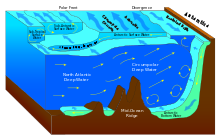|
Protomyctophum Bolini
''Protomyctophum bolini'' is a species of lanternfish. Distribution Circumpolar deep water, Circumpolar between Antarctic Divergence and Antarctic Convergence, Subtropical Convergence zone. Southeast Atlantic and Western Indian Ocean: between 41°40'-45°25'S, 17°17'-36°32'E References Lampanyctus Fish described in 1949 {{Myctophiformes-stub ... [...More Info...] [...Related Items...] OR: [Wikipedia] [Google] [Baidu] |
Lanternfish
Lanternfishes (or myctophids, from the Greek μυκτήρ ''myktḗr'', "nose" and ''ophis'', "serpent") are small mesopelagic fish of the large family Myctophidae. One of two families in the order Myctophiformes, the Myctophidae are represented by 246 species in 33 genera, and are found in oceans worldwide. Lanternfishes are aptly named after their conspicuous use of bioluminescence. Their sister family, the Neoscopelidae, are much fewer in number but superficially very similar; at least one neoscopelid shares the common name "lanternfish": the large-scaled lantern fish, ''Neoscopelus macrolepidotus''. Lanternfish are among the most widely distributed, diverse and populous vertebrates, with some estimates suggesting that they may have a total global biomass of 1.8 to 16 gigatonnes, accounting for up to 65% of all deep-sea fish biomass. Commercial fisheries for them exist off South Africa, in the sub-Antarctic, and in the Gulf of Oman. Description Lanternfish typically hav ... [...More Info...] [...Related Items...] OR: [Wikipedia] [Google] [Baidu] |
Circumpolar Deep Water
Circumpolar Deep Water (CDW) is a designation given to the water mass in the Pacific and Indian oceans that is a mixing of other water masses in the region. It is characteristically warmer and saltier than the surrounding water masses, causing CDW to contribute to the melting of ice shelves in the Antarctic region. Physical Properties CDW, the greatest volume water mass in the Southern Ocean, includes the North Atlantic Deep Water (NADW), the Antarctic Bottom Water (AABW), Antarctic Intermediate Water (AAIW), as well as recirculated deep water from the Indian and Pacific Oceans. A distinguishing characteristic of the CDW is that the water is not formed at the surface, but rather by a blending of other water masses. CDW sits at a depth of around 500 meters, approximately at the depth of the continental shelf. There are two types of CDW: Upper Circumpolar Deep Water (UCDW) and Lower Circumpolar Deep Water (LCDW). UCDW originates in the Indian and Pacific Oceans and has lower ... [...More Info...] [...Related Items...] OR: [Wikipedia] [Google] [Baidu] |
Antarctic Convergence
The Antarctic Convergence or Antarctic Polar Front is a marine belt encircling Antarctica, varying in latitude seasonally, where cold, northward-flowing Antarctic waters meet the relatively warmer waters of the sub-Antarctic. Antarctic waters predominantly sink beneath the warmer subantarctic waters, while associated zones of mixing and upwelling create a zone very high in marine productivity, especially for Antarctic krill. This line, like the arctic tree line, is a natural boundary rather than an artificial one, such as the borders of nations and time zones. It not only separates two hydrological regions, but also separates areas of distinctive marine life and climates. The Arctic has no similar boundary because of the large bodies of land contiguous with the northern polar region. History The Antarctic Convergence was first crossed by Anthony de la Roché in 1675, and described by Edmond Halley in 1700. Location The Antarctic Convergence is a zone approximately wide, ... [...More Info...] [...Related Items...] OR: [Wikipedia] [Google] [Baidu] |
Lampanyctus
''Lampanyctus'' is a genus of lanternfishes. Species There are currently 39 recognized species in this genus: * ''Lampanyctus acanthurus'' Wisner, 1974 (Spinytail lampfish) * ''Lampanyctus achirus'' Andriashev, 1962 (Cripplefin Lanternfish) * ''Lampanyctus alatus'' Goode & T. H. Bean, 1896 (Winged lanternfish) * ''Lampanyctus ater'' Tåning, 1928 (Dusky lanternfish) * ''Lampanyctus australis'' Tåning, 1932 (Southern lanternfish) * ''Lampanyctus bristori'' Zahuranec, 2000 * ''Lampanyctus crocodilus'' ( A. Risso, 1810) (Jewel lanternfish) * ''Lampanyctus crypticus'' Zahuranec, 2000 * '' Lampanyctus cuprarius'' Tåning, 1928 * '' Lampanyctus festivus'' Tåning, 1928 (Festive lanternfish) * '' Lampanyctus gibbsi'' Zahuranec, 2000 * '' Lampanyctus hawaiiensis'' Zahuranec, 2000 * '' Lampanyctus hubbsi'' Wisner, 1963 * '' Lampanyctus idostigma'' A. E. Parr, 1931 * '' Lampanyctus indicus'' Zahuranec, 2000 * '' Lampanyctus intricarius'' Tåning, 1928 (Diamondcheek lante ... [...More Info...] [...Related Items...] OR: [Wikipedia] [Google] [Baidu] |

